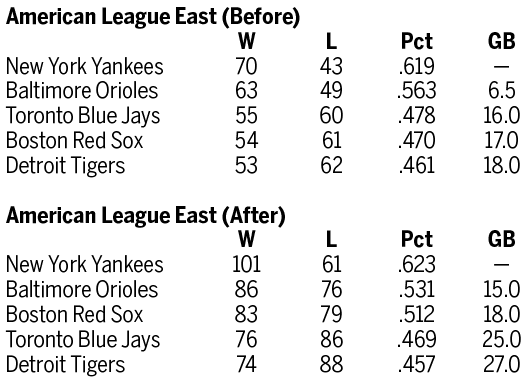

In 1992, Fay Vincent had been fired as commissioner and replaced-then on an ‘interim’ basis–by Selig, then the owner of the Milwaukee Brewers. The owners had colluded to suppress salaries and free-agent movement – independent arbitrators had ruled for the players in all three collusion hearings, with MLB owners paying out $393 million in damages and penalties. In 1994 negotiations were being conducted against a history of bitterness and distrust. The purpose was to pay the players as little as you can and maintain as much control as you can maintain,” he says. Another lesson he learned going back to the late ‘70s when he was hired to be the association’s general counsel by Marvin Miller? “The purpose of collective bargaining (for ownership) was not to reach agreement.
#1994 mlb strike newspaper free#
“The owners position in all these disputes was that free agency was the end of baseball, if not the world,” said Fehr.

“It was as ugly a time as there has been in the game.”Įach dispute had its own set of issues, but however it was couched, the background in all of the disputes seemed the same for Fehr, the current executive director of the NHL Players’ Association who was executive director of the Major League Baseball Players’ Association from 1985-2009. And, at that point in time, we were all in a kind of no-man’s land. The owners called the union’s bluff by cancelling the World Series. The union called the owners’ bluff by striking. Paul Beeston, the former Toronto Blue Jays president who became president and chief executive officer of Major League Baseball for a five-year period beginning in 1997, puts it more bluntly: “The reality was that it was a war waiting to happen. You get this little window of time where everybody gets in the right frame of mind … and then all of a sudden you get distracted.” “Some of those opportunities were missed because of the publicity issues. “I mean, there were multiple opportunities where an agreement could have been reached. “We wasted more time in 1994 going back and forth over whom had said what publicly, and we just avoided all that in the negotiations that occurred over the next period of time,” says Rob Manfred, the commissioner of Major League Baseball who served as ownership’s outside legal counsel in 1994 and eventually became then-commissioner Selig’s point-man on labour matters. The fact that there hasn’t been one since is no accident. The 1994 strike was the eighth labour stoppage in baseball history, beginning with a 12-day strike in 1972 over pension issues. It left Clinton, who could send people off to war, expressing frustration at his role in having to play “umpire.” But ownership wouldn’t agree to submit to binding arbitration or a plan that would allow the players to return to work under terms of the previous CBA while a presidential commission investigated the next step. Vice-president Al Gore was there labour secretary Robert Reich was there. 7, 1995, just eight days before the owners were scheduled to open spring training with scab or “replacement” players.

The owners were eventually steamrolled in the legal arena and forced to give in, but not before five bills had been introduced in Congress – Congress, for Pete’s sake! – attempting to end the strike, and not before President Bill Clinton had invited the sides to negotiate in the Roosevelt Room of the White House on Feb. It lost 948 games and broke faith with sponsors, broadcasters and most importantly, fans. It lost an estimated $1 billion (U.S.) in revenue. It’s an overly-simplistic notion built on unfounded optimism, but, my goodness: what is baseball all about if not dreams and optimism?īaseball lost a great deal in the 1994 strike. And while it was a decade-long road from Rondell White grounding into the game’s final out in ’94 and Jeffrey Loria greasing the skids for the team’s eventual departure, it’s still easy to find people who think the Expos would have gone to the World Series, used that momentum to build a new stadium and they never would have left.

The Expos had the best record in the Majors when players walked out – they were 74-40 when the curtain fell after a 4-0 loss to the Pittsburgh Pirates on Aug.


 0 kommentar(er)
0 kommentar(er)
